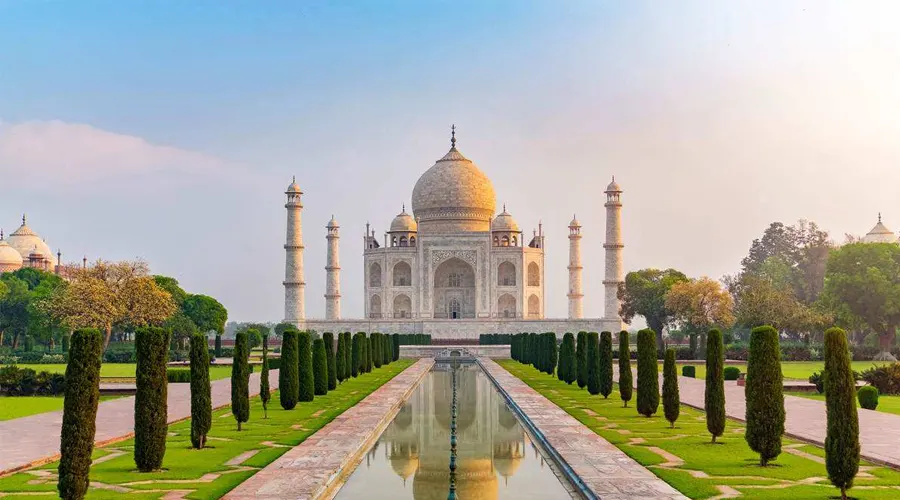One of the seven wonders of the world - The Taj Mahal
Undoubtedly one of Agra’s most popular attractions, the Taj Mahal isn't simply famed in India but also a monument noted across the globe. Built by Mughal Emperor Shah Jahan for his deceased wife Mumtaz, it's emblematic of the emperor’s deep love for his wife and the grief he experienced at her passing. A landmark monument and a UNESCO World Heritage site, the Taj Mahal is one of the most admired Mughal masterpieces within the world and is nothing short of poetry crafted in marble. The architect of the Taj Mahal was Ustad Ahmed Lahauri and the style is representative of Indian, Persian, and Muslim forms of design. It took twenty-one years for the Taj Mahal to be constructed (from 1632 to 1652) with over 20,000 laborers working night and day.
Described as a “teardrop on the face of eternity” by legendary writer Rabindranath Tagore, the Taj Mahal never fails to impress visitors. Take a relaxed stroll through the grounds or simply just sit and admire the beautiful, reflective pools and exquisite gardens on the premises. To expertise, its ethereal beauty, visit the Taj Mahal early in the morning when it’s comparatively quieter and less crowded or on a phase of the moon night when the white marble glows against the scenery of the dark, night sky.
Taj Mahal Architecture
The Taj Complex
The ornamental gardens designed on the lines of the typical Mughal Charbagh is a square garden compound by water bodies with a decorative marble plinth running through its center. To the northern end of the complex is the elevated marble platform on which the main mausoleum stands. The raised pulpit is to lift it above the other structures on the complex as if reaching out to the very skies. A 40-meter-high white minaret adorns every corner of the marble platform and calls it an engineering masterstroke, the towers each slightly lean outward. This was so that they fall away just in case of an earthquake and let the superstructure remain unperturbed.
Buildings on the Taj Mahal Complex
The main entrance to Taj is an ornate Mughal structure predominantly made of white marble with tomb-like archways. The arches are rich in calligraphy and have domed ceilings and walls with geometric designs. On the other end of the structure, there are two identical red sandstone buildings, the western building is a mosque, and its prototype, a jawab (answer).
Taj Mahal Central Structure
Built-in semi-translucent white marble with intricate carvings and inlay work of precious and semi-precious gems, the four identical sides of the mausoleum are majestic in their particularization. Four small domes are topping the central structure with one large bulbous dome in the center. Right below the most dome lies the cenotaph of Mumtaz Mahal with beautiful jaali and inlay work in marble, and beside it the cenotaph of her husband. The construction is such that sunlight streams indirectly through the jaali and falls on the cenotaphs. But the actual tombs of Shah Jahan and Mumtaz are in a chamber in a basement room that is not open for public viewing.
Some Quick Facts about Taj Mahal
- A 1000 elephants were used to transport building materials for the construction of the Taj.
- The brilliant white marble came in from Makrana in Rajasthan, the jade and crystal came from China, the jasper from Punjab, the turquoise from Tibet, the Lapis Lazuli from Afghanistan, the carnelian from Arabia, and the sapphire from Sri Lanka.
- The famous inlay work on the marble has about 28 varieties of precious and semi-precious stones.
A visit to the Taj Mahal at Night
“Only let this one tear-drop, this Taj Mahal, glisten spotlessly bright on the cheek of time, forever and ever.” - Rabindranath Tagore
A celebration by the day, of Agra‘s traveler rush, of native pride, and all the tales of love and history it's spun about and keeps guarded in its walls which escape occasionally leaves its visitors in awe in the dead of night. Taj Mahal's post-sunset is sparkling, unreal, and glowing white.
Viewing the Taj Mahal at night is available five days a month, including a full moon night and two nights before and after the full moon. All these aspects, the dates, and the timings for the night viewing of the Taj are decided by the Archaeological Survey of India. Viewing the Taj Mahal at night takes place between 8:30 pm to 12:30 am in 8 batches of about 50 people for about 30 minutes each. Hence, only 400 people are allowed on a single night.
While visiting the Taj Mahal at night, visitors are required to reach half an hour before their scheduled time at the Shilpagram complex. They aren’t allowed inside the monument at night and can view the Taj Mahal only from a bit of a distance. All belongings and luggage have to be deposited at a security counter before the night viewing starts. Video cameras are not allowed inside the monument during the night viewing.


Comments (0)